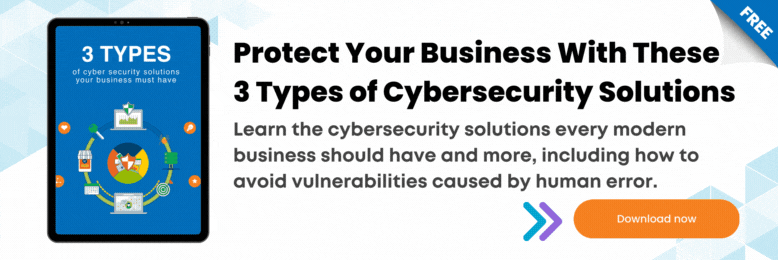Why your Cybersecurity Awareness Training isn’t Working?
August 13th, 2021 | 5 min. read

Is your team leaving your business vulnerable to attack despite conducting regular security awareness training? Find out why your cybersecurity training program might be failing, what you can do to improve it and what tools you can use to make it more effective.
Imagine yourself in this scenario: Your business has deployed the best and latest cybersecurity tools in the industry, but security breaches are still popping up. So what’s the deal?
What your organization might be experiencing is one of the biggest cybersecurity threats ever known -- human error.
This is a common scenario that we, at ITS, have encountered countless times over the years providing cybersecurity services to hundreds of businesses.
Whether it’s clicking on a malicious link or accessing sensitive data through unsecured Wi-Fi, employee negligence might be the biggest cybersecurity risk for your business.
But don’t put the blame on your team just yet.
According to a survey conducted by Forrester Consulting, 50% of IT managers believe they are ticking all the boxes when it comes to security compliance. However, their employees disagreed. In fact, 51% of employees surveyed believed that their IT managers did not stress the importance of good security practices.
That disconnect is the reason many security awareness training programs fail. Because teaching people about cybersecurity isn’t as simple as glossing over a ton of information and expecting them to comply. It’s about changing behaviors. And one of the most effective ways of doing that is by actively and consistently engaging people.
In this article, we will discuss ways to help you raise cybersecurity awareness in your organization that can lead to positive behavioral change. To do that, we will be addressing the following:
- Three reasons why most cybersecurity awareness training fail
- How can I make my team’s cybersecurity awareness training more effective?
- What tools can I use to improve my team’s cybersecurity awareness?
Top Three Reasons Why Most Cybersecurity Awareness Training Fail
The answer to this question could be a combination of different factors. However, the main reasons why most training programs fail are because of the following:
1. No Plans

One of the main reasons training programs fail is due to a lack of proper planning. Without constructing a solid framework or defining actionable goals and milestones, your program will only leave your team uninterested and unsure of their role in cybersecurity.
Many companies conduct security awareness training in an ad hoc manner, without a solid framework or plan. The program then becomes an information dump wherein the audience is given more information than they can process, resulting in a disconnect.
Cybersecurity awareness is not an event. It’s a long-term project. Planning what message to deliver as well as when and how to deliver it to make the most impact is paramount to your program’s success. Defining security goals and milestones and setting company expectations should also factor into a solid training plan.
2. Not Engaging

It doesn’t matter how often you conduct security awareness training sessions; if your training content is boring, then no one’s paying attention. Facts and statistics have their place. When done sparingly, it can leave a lasting impact. However, if all you are communicating are facts and numbers, they lose all their meaning.
3. One-and-Done Approach

Cybersecurity awareness should be an ongoing pursuit. It’s not a one-and-done deal. The goal is to help people form good habits that can lead to positive behavioral change. To do that, you need to communicate security practices and messages regularly. Incorporate the message into weekly meetings or email reminders to help create a culture of awareness.
How can I make my team’s cybersecurity awareness training more effective?
As we’ve discussed earlier, IT managers ticking that security compliance box with regular training sessions doesn’t necessarily mean your employees are getting the picture. Getting your message across requires more than just regular lectures on cybersecurity. Here are a few things you can do to improve your team’s security awareness:
Reframe Your Goals
 In order to get effective results that can lead to positive action, you need to reframe your goal from getting it done and ticking that box to ensuring everyone is engaged and actively taking part in cybersecurity.
In order to get effective results that can lead to positive action, you need to reframe your goal from getting it done and ticking that box to ensuring everyone is engaged and actively taking part in cybersecurity.
Each member of your team is a key player in securing your network; that’s why ensuring that everyone knows they have a role to play and have goals they can act on is vital.
Directing your team to aim for concrete objectives like raising their scores on knowledge assessment exercises (like quizzes and attack simulations) not only helps demystify cybersecurity, it reinforces the message that their knowledge and actions matter.
Practice makes perfect

Reading or hearing about a topic is one thing; putting it into practice is another. Actively engaging your team with attack simulations and other similar activities will help teach them how to detect an attack and what to do when they encounter one. That helps abstract ideas like cybersecurity seem more concrete and something that they can act upon.
It also helps you keep track of whether your security awareness efforts are actually getting through to your team.
Make it relatable

While it might seem like a no-brainer, making sure that your team is paying attention to the message is essential. The problem is that security awareness training is conducted most of the time in a way that may be interesting for an IT expert but unappealing to the rest of your employees.
The content of your training should not only be bite-sized and easily digestible for everyone, but most of all, it needs to be interesting.
One way to do that is by creating training content that appeals to people’s emotions, not just their logic. Our emotions can influence decision-making and urge people to act. Making use of this psychological trait can help you maximize the impact of each session.
Appealing to emotions is a tactic often used by the most successful advertisers. They establish emotional connections through a deep understanding of their audience and weave relatable stories that feel authentic. In turn, their content becomes more memorable, shareable, and more persuasive.
If you can take a page out of the advertiser’s playbook and apply this tactic to your training program, then you can rest assured more members of your team will pay attention to your message.
Make it a habit

To change a person’s behavior, you first need to turn it into a habit. This will require you and your team to change your mindsets.
Adopt a mindset of not depending too much on your cybersecurity tools and focus on what you can do outside of technology to help secure your network. Doing that will help create good security habits that make a lasting impact.
What tools can I use to improve my team’s cybersecurity awareness?
There are many tools available that can help your business achieve effective cybersecurity awareness training practices. However, for this article, we will take a look at two of the most noteworthy examples we’ve seen so far:
Ninjio
Ninjio is a cybersecurity awareness training solution that uses a series of engaging four-minute micro-learning videos to inform and empower your team to defend against cyber threats.
The program simplifies cybersecurity concepts and turns them into entertaining and informative cartoons. The result is a highly engaging way to teach your team how to detect and react to security threats.
Ninjio also employs regular security awareness reminders via email and simulated attacks to help deepen your team’s understanding of their role in securing your network.
It also offers a comprehensive analytics tool that allows you to know where your organization is currently at with cybersecurity awareness. The data includes the name of your team members, what device and IP address they were on, whether they clicked on the simulated attack, and what information they gave up.
Microsoft Cybersecurity Awareness Kit
As part of Microsoft’s suite of tools, the Microsoft Cybersecurity Awareness Kit is highly integrated with Office 365. A boon if your current setup is already running on Microsoft systems.
The program can conduct a simulated phishing attack. People who fall victim to the fake attack are then given the task of accomplishing cybersecurity awareness through the platform.
Ready to conduct cybersecurity awareness training that makes an impact?
You may have the best security tools in the market; however, if you don’t train your team how to detect and deal with threats effectively, then you're leaving yourself vulnerable to attack.
Phishing and social engineering attacks are threats that take advantage of human psychology. The only way to combat these threats isn’t by upgrading your tech; it’s by upskilling your people.
It’s the main reason why ITS always recommends that our clients implement cybersecurity awareness programs. Because based on our experience your team should be your first line of defense.
Want to conduct cybersecurity awareness training that makes an impact? Check out this article to find out the components of an effective program.
Mark Sheldon Villanueva has over a decade of experience creating engaging content for companies based in Asia, Australia and North America. He has produced all manner of creative content for small local businesses and large multinational corporations that span a wide variety of industries. Mark also used to work as a content team leader for an award-winning digital marketing agency based in Singapore.
Topics:
